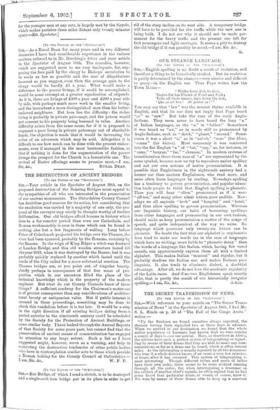THE DESTRUCTION OF ANCIENT BRIDGES.
[To THE EDITOR OP THE "SPECTATOR."] SID,—Your article in the Spectator of August 30th on the proposed destruction of the Sonning Bridges must appeal to the sympathies of all who are interested in the preservation of our ancient monuments. The Oxfordshire County Council has doubtless good reasons for its action, but considering that the resolution was carried by a majority of one only, the pro- posal of the surveyor may surely be thought worthy of further deliberation. Ou• old bridges afford lessons in history which date to a far remoter period than even our Cathedrals, and Roman workmanship is seen in them which can be found in nothing else but a few fragments of walling. Long before Peter of Colechurch projected his bridge over the Thames, the river had been spanned, probably by the Romans, certainly by the Saxons. In the reign of King Edgar a witch was drowned at London Bridge, and this old wooden structure lasted till the year 1013, when it was destroyed by the Danes ; but it was probably quickly replaced by another which lasted until the needs of the City called for a more substantial erection. The Thames bridges are, as you point out, of singular beauty, chiefly perhaps in consequence of that fine sense of pro- portion which in our ancestors filled the place of the technical knowledge which is the property of the modern engineer. But what do our County Councils know of these things? A sufficient roadway for the Chairman's motor•-car is of greater consequence than any considerations of architec- tural beauty or antiquarian value. But if public interest is aroused in these proceedings, something may be done to check this vandalism before it is too late. It would be a step in the right direction if all existing bridges dating from a period anterior to the nineteenth century could be scheduled by the Society for the Protection of Ancient Buildings, or some similar body. I have looked through the Annual Reports of that Society for some years past, but cannot find that the preservation of ancient means of communication has engaged ite attention to any large extent. Such a list as I have suggested might, however, serve as a warning, and help in restricting the destructive tendencies of other public bodies who have in contemplation similar acts to those which provide a Roman holiday for the County Council of Oxfordshire.—






































 Previous page
Previous page